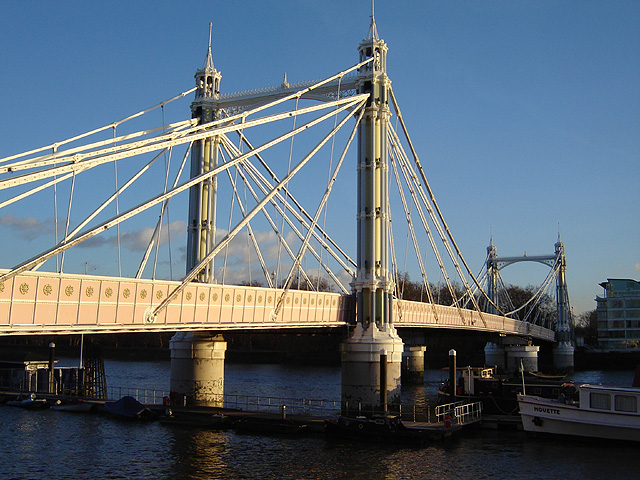Ordish–Lefeuvre system on:
[Wikipedia]
[Google]
[Amazon]
The Ordish–Lefeuvre system or principle is an early form of  Albert Bridge was inspected in 1884 by Sir Joseph Bazalgette, Chief Engineer of the
Albert Bridge was inspected in 1884 by Sir Joseph Bazalgette, Chief Engineer of the
cable-stayed bridge
A cable-stayed bridge has one or more ''towers'' (or ''pylons''), from which wire rope, cables support the bridge deck. A distinctive feature are the cables or wikt:stay#Etymology 3, stays, which run directly from the tower to the deck, norm ...
design, patented by English engineers Rowland Mason Ordish
Rowland Mason Ordish (11 April 1824 – 1886) was an English engineer. He is most noted for his design of the Winter Garden, Dublin (1865), for his detailed work on the single-span roof of London's St Pancras railway station, undertaken with Wil ...
and William Henry Le Feuvre in 1858.
The Ordish–Lefeuvre system differs from conventional suspension bridge
A suspension bridge is a type of bridge in which the deck (bridge), deck is hung below suspension wire rope, cables on vertical suspenders. The first modern examples of this type of bridge were built in the early 1800s. Simple suspension bridg ...
s in that, while as with a conventional suspension bridge a parabolic cable supports the centre of the bridge, inclined stays support the remainder of the bridge's load. Each stay consists of a flat wrought iron
Wrought iron is an iron alloy with a very low carbon content (less than 0.05%) in contrast to that of cast iron (2.1% to 4.5%), or 0.25 for low carbon "mild" steel. Wrought iron is manufactured by heating and melting high carbon cast iron in an ...
bar attached to the bridge deck, and a wire rope
Steel wire rope (right hand lang lay)
Wire rope is composed of as few as two solid, metal wires twisted into a helix that forms a composite ''rope'', in a pattern known as ''laid rope''. Larger diameter wire rope consists of multiple strands of ...
connects the wrought iron bar to one of four octagonal support columns.
Only two major bridges were built using the Ordish–Lefeuvre principle. Ordish was commissioned to build Albert Bridge in Chelsea, London
Chelsea is an area in West London, England, due south-west of Kilometre zero#Great Britain, Charing Cross by approximately . It lies on the north bank of the River Thames and for postal purposes is part of the SW postcode area, south-western p ...
, using the design in 1864, but the start of work on the bridge was delayed due to negotiations regarding the proposed Chelsea Embankment
Chelsea Embankment is part of the Thames Embankment, a road and walkway along the north bank of the River Thames in central London, England.
The western end of Chelsea Embankment, including a stretch of Cheyne Walk, is in the Royal Borough of ...
at the northern end of the proposed bridge. While plans for the Chelsea Embankment were debated, Ordish built the Franz Joseph Bridge over the Vltava
The Vltava ( , ; ) is the longest river in the Czech Republic, a left tributary of the Elbe River. It runs southeast along the Bohemian Forest and then north across Bohemia, through Český Krumlov, České Budějovice, and Prague. It is com ...
in Prague
Prague ( ; ) is the capital and List of cities and towns in the Czech Republic, largest city of the Czech Republic and the historical capital of Bohemia. Prague, located on the Vltava River, has a population of about 1.4 million, while its P ...
to the same design as that intended for Albert Bridge.
In 1870 work finally began on Albert Bridge, with construction expected to take roughly a year. In the event, construction took over three years, and the bridge opened with no formal ceremony on 23 August 1873, almost ten years after it had been authorised.
 Albert Bridge was inspected in 1884 by Sir Joseph Bazalgette, Chief Engineer of the
Albert Bridge was inspected in 1884 by Sir Joseph Bazalgette, Chief Engineer of the Metropolitan Board of Works
The Metropolitan Board of Works (MBW) was the upper tier of local government for London between 1856 and 1889, primarily responsible for upgrading infrastructure. It also had a parks and open spaces committee which set aside and opened up severa ...
, who found that the steel rods were already showing serious signs of corrosion. Over the next three years the steel staying rods were augmented with steel chains, giving it an appearance more closely resembling a conventional suspension bridge, and a new timber deck was laid. Albert Bridge continued to suffer serious structural weakness and in 1972 the Greater London Council
The Greater London Council (GLC) was the top-tier local government administrative body for Greater London from 1965 to 1986. It replaced the earlier London County Council (LCC) which had covered a much smaller area. The GLC was dissolved in 198 ...
added two concrete piers in the middle of the river, supporting the central span and turning the central section of the bridge into a beam bridge
Beam bridges are the simplest structural forms for bridge spans supported by an abutment or pier at each end. No moments are transferred throughout the support, hence their structural type is known as '' simply supported''.
The simplest beam ...
.
Damaged through overuse during the Second World War
World War II or the Second World War (1 September 1939 – 2 September 1945) was a World war, global conflict between two coalitions: the Allies of World War II, Allies and the Axis powers. World War II by country, Nearly all of the wo ...
, the Franz Joseph Bridge was demolished in the 1950s and replaced with a conventional bridge, leaving Albert Bridge the only surviving example of a significant bridge built using the Ordish–Lefeuvre principle.
Notes and references
;References ;Bibliography * * * * * * {{DEFAULTSORT:Ordish-Lefeuvre system Bridges 1858 introductions